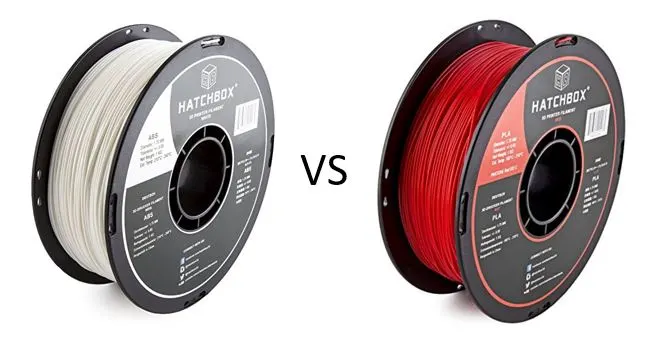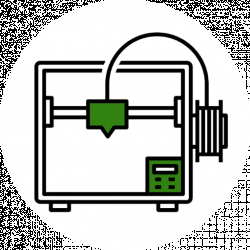- Creality Ender vs Anet A8 [2022]: Which is Better? - April 14, 2022
- TEVO Tornado Review [2022] All You Need To Know - April 6, 2022
- Anet A6 Review [2022 UPDATED Version] - April 5, 2022
3D printing is an exciting industry with new developments and ways of doing things emerging almost daily. If you haven’t tried your hand at 3D printing or relatively new it can be very useful to understand some of the basic concepts involved and how to work with different materials.
Two of the core materials used in the industry for 3D printers are PLA and ABS filaments. These are used Fused Deposition Modeling Technology, also called FDM. Understanding the pros and cons of PLA vs ABS filaments can help you better understand projects and the results you’re looking for. Both of these materials are a thermoplastic, which means you can easily shape and manipulate them in various ways once they are heated.
Additionally, once these materials go through the cooling down process they retain their shape. ABS and PLA are both widely available and used in the 3D printing market because they are generally easy to work with and compatible with almost all 3D printer models. While these materials do share a number of similarities they also differ in many ways as well, which can make 3D printing projects easier or more difficult depending on the job.
Table of Contents
What is ABS?
ABS stands for Acrylonitrile Butadiene Styrene, which is a plastic that is oil-based. Businesses tend to use ABS frequently because it’s a very strong material that is good for making parts for cars, different types of musical instrument components and even Legos. Its melting point is relatively high compared to other materials and you have to be careful of potential warping during the cooling/printing process.
Because ABS is subject to warping during the printing process, it’s usually necessary to utilize a heated printing bed which is not always included with every type of 3D printer, especially less expensive models. Additionally, the fumes that come with using ABS can be quite unpleasant so printing in an area that is well ventilated is important. Some of these aspects make this material more geared towards professional applications as opposed to a typical 3D printing hobbyist.
What is PLA?
PLA stands for Poly Lactic Acid and is actually made from a mixture of cornstarch and sugarcane. It is much safer to use compared to ABS and in many cases it’s easier to work with. Additionally, PLA can provide a nicer appearance as its surface is smooth and shiny which is preferred when 3D printing many products.
This material does not present the same issue with fumes as ABS but it does have its downsides. It is not near as strong or durable as ABS and the melting point is significantly lower. This means if you were to use it for building parts for cars or other applications that require durability, the material won’t hold up very well especially in extreme hot or cold conditions.
ABS Applications and Advantages
Typical applications and uses for ABS cover a wide range of products but include drain pipes, electronic components, kitchen appliance parts, carrying cases and even many toys or toy parts. The balance of flexibility and durability is what make this material so useful for many commercial uses. Because it is relatively resistant to heat, 3D printers that are can use ABS use a hot end which melts the material before it is fed through the nozzle.
This typically happens in a temperature range of between two hundred ten and two hundred fifty degrees Celsius.
“As mentioned above, these elements of working with ABS make it necessary to use a printer that has a heated print bed as well as a hot end which helps reduce breakage of printed components.”
Another significant advantage of utilizing ABS besides its durability is cost. ABS is significantly less expensive compared to PLA. For many years, this made it the most used material 3D printing, although that is slowly changing with new printer models and techniques becoming available. It is available in a wide range of colors and typically offers a matte type finish on printed products.
Disadvantages of ABS
The first issue working with ABS creates is that it is a non-biodegradable plastic due to its oil base. The unpleasant fumes are becoming less of an issue as time goes by due to some printer models offering HEPA filters of various types which remove most of the problem.
However, the material can become unstable and lose its structural integrity when exposed to natural sunlight for long periods of time, so proper storage is essential. Keep in mind, this means you must store unused spools of ABS material in a safe place.
PLA Applications and Advantages
PLA is made from several different resources such as corn and potato starch as well as tapioca roots, which makes it biodegradable. Compared to the other thermoplastics available in the 3D printing market, PLA is the most environmentally friendly. While it is less durable than ABS it does have its place for use in commercial applications.
The medical industry utilizes PLA quite often to produce pins, screws or rods that are used for various types of medical implants. Within a couple of years, the PLA-based components of an implant will break down inside the body well after they are needed and not harmful.
Additionally, PLA is used for producing all different types of packaging such as shopping bags, disposable forks and spoons as well as a large array of disposable garments.
“The material is a good match for any type of product that needs to be environmentally friendly but does not require permanent structural integrity.”
The melting point for PLA is much lower than ABS and stands between one hundred sixty and two hundred twenty degrees Celsius. A heated printed bed is optional when you work with this material but it can help depending on what type of printing project or object you are trying to print. Additionally, PLA cools slower than other 3D printing materials so it can be useful to use a fan to make the cooling process faster. PLA does not present any fume issues like ABS as it actually smells quite sweet when melted due to the resources that make up the material. This makes it easy to work with in a house, garage or basement where you might have other people close to your work area.
PLA Disadvantages
PLA does have its disadvantages too as it can be a bit sensitive or difficult to work with in some aspects. It has a tendency to be very sticky which means it can sometimes stick to your fingers or other surfaces when you are trying to move or work with an object. This can cause unwanted breakage if the force becomes too great and a printed object has not had time to fully cool.
PLA can also sometimes be a bit difficult to work with when it comes to painting objects and often requires using a coat of primer first. Of course, the obvious disadvantage is its durability which does not make it a good material for any type of device that needs to hold up to any significant amount of pressure or force.
PLA vs ABS Filament – Final Thoughts
Deciding which material is better for your 3D printing purposes will largely depend on what types of objects you are printing.
Structural Integrity: If you need a material that can withstand force and offers a high degree of structural integrity then ABS is the obvious choice.
Flexibility and Fun: If you are a hobbyist and just starting out then the ease of use, no fumes and no toxicity of PLA may be a better choice. Whatever you choose, have fun, be creative and keep on 3D printing!


